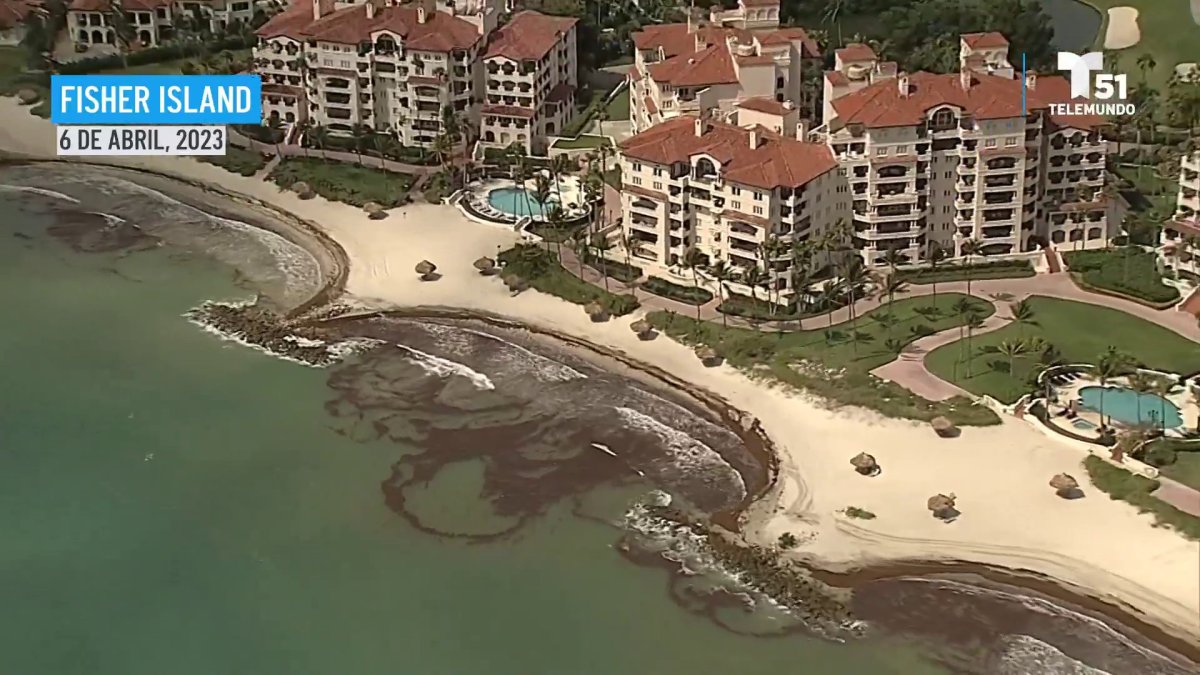A 5,000-mile belt floating in the Atlantic Ocean has begun washing up on beaches in southern Florida, the Caribbean and Mexico’s Yucatan Peninsula.
The Great Atlantic Sargassum Belt – as the biomass that stretches from West Africa to the Gulf of Mexico is called – consists of scattered patches of open-ocean algae, rather than a mass continues to sargassum. It’s not a new phenomenon, but satellite images taken in February showed an earlier than usual onset for such a large accumulation over the ocean.
Once ashore, Sargassum is a nuisance: a leafy brown algae that coats beaches, giving off a foul odor as it decomposes, entangling humans and animals walking on it. For hotels and resorts, beach cleaning can become a 24-hour operation.
Here is an overview of the Sargassum bloom this year:
WHAT IS SARGASS?
Sargassum is a seaweed adorned with what looks like berries. It floats in the open sea and, unlike other algae, it reproduces on the surface of the water, aided by air-filled structures that give it its buoyancy.
It originates in a vast expanse of the Atlantic Ocean called the Sargasso Sea, located a considerable distance from the southeastern United States. This sea is not bounded by any coast; instead, four ocean currents set its boundaries.
The tangled brown algae stretches for miles in the ocean and provides breeding, feeding and habitat space for fish, turtles and seabirds, according to the acronym in English for the National United States Oceanic and Atmospheric Administration (NOAA).
“It’s a dynamic, ever-changing series of pieces of this enormous mass,” said Rick Lumpkin, director of NOAA’s Physical Oceanography Division. “It’s not a big, continuous slick heading straight into South Florida.”
WHY A PROBLEM?
Sargassum accumulates on beaches, where it quickly decomposes in the sun, releasing gases that smell like rotten eggs.
In recent years, he has covered the beaches of some Caribbean islands and the Yucatan Peninsula in spring and summer. Cities and coastal towns have struggled to remove the huge amounts of algae that cover the sand.
WHAT IS THE SITUATION THIS YEAR?
Some of the sargassum has already washed up on beaches in Key West, Florida (also known locally in Spanish as Key West), said Chuanmin Hu, a professor of oceanography at the University of South Florida. But most will arrive in the summer, he warned.
“What’s unusual about this year compared to previous years is that it started early,” Hu said. The seaweed usually blooms in spring and summer, but “this year, in winter, we already have a lot of it.”
South Florida, the Caribbean and the Yucatan Peninsula typically see sargassum buildup during the summer months and could expect the same this year, Hu said.
IS THE HUGE WAVE OF SARGASES UNUSUAL?
That’s a lot, but there have been worse years. Scientists estimate that there are over 10 million tons of Sargassum in the strip this year. Lumpkin said it was “one of the years with the most, but not the year with the most” since scientists began looking closely at biomass through satellite imagery in 2011.
He said there were more in 2018. A large amount of Sargassum was also recorded in 2019 and 2021, he noted.
WHY IS IT PRODUCED?
Scientists aren’t entirely sure, in part because it wasn’t closely monitored until 2011.
“We know that for there to be a lot of algae, you need nutrients and sunlight. Of course, as you get closer to the equator, there will be more sun,” said Mike Parsons, professor of marine science at Florida Gulf Coast University.
Parsons and other experts say agricultural runoff seeping into the Amazon and Orinoco rivers and eventually ending up in the ocean could account for the band’s increased size on its western side. Parsons said warm waters likely help algae grow faster. Changes in wind patterns, ocean currents, rainfall and drought could also affect outbreaks.
“It could be that the whole belt is fed more in some years than others by dust containing iron and other nutrients from the Sahara Desert,” said NOAA’s Lumpkin.
It’s unclear if climate change has anything to do with it. Hu said more frequent extreme weather due to global warming – high winds, storms, increased rainfall – could contribute.
IS SARGASS HARMFUL TO HUMAN HEALTH?
It can be. When sargassum breaks down, it releases ammonia and hydrogen sulfide, causing the rotten egg stench. Brief exposure to these gases is not enough to make someone sick, but prolonged exposure – especially in people with respiratory problems – can be dangerous, scientists warn.
Hu said that could be a problem for hotel workers and others who could spend hours removing rotting sargassum from beaches.
If left to rot on the sand, Sargassum can harm coastal marine ecosystems and also promote the growth of fecal bacteria.

